Organizational Behaviour Report: Structure, Culture, and Leadership
VerifiedAdded on 2019/12/03
|15
|3820
|195
Report
AI Summary
This report delves into organizational behaviour, examining the interplay between organizational structure and culture, particularly within Marks & Spencer plc. It explores various organizational structures, including functional, product-based, and geographically-based models, and compares different organizational cultures like power-based, role-based, and task-based cultures. The report investigates factors affecting individual behaviour, such as leadership, work culture, job responsibilities, and communication. It also discusses organizational theories, including classical, neoclassical, and modern approaches, alongside Henry Fayol's 14 principles of management. Furthermore, the report compares leadership styles, contrasting democratic and autocratic approaches, and evaluates the impact of different leadership styles on motivation. Finally, it explores the application and usefulness of various motivational theories within organizations.
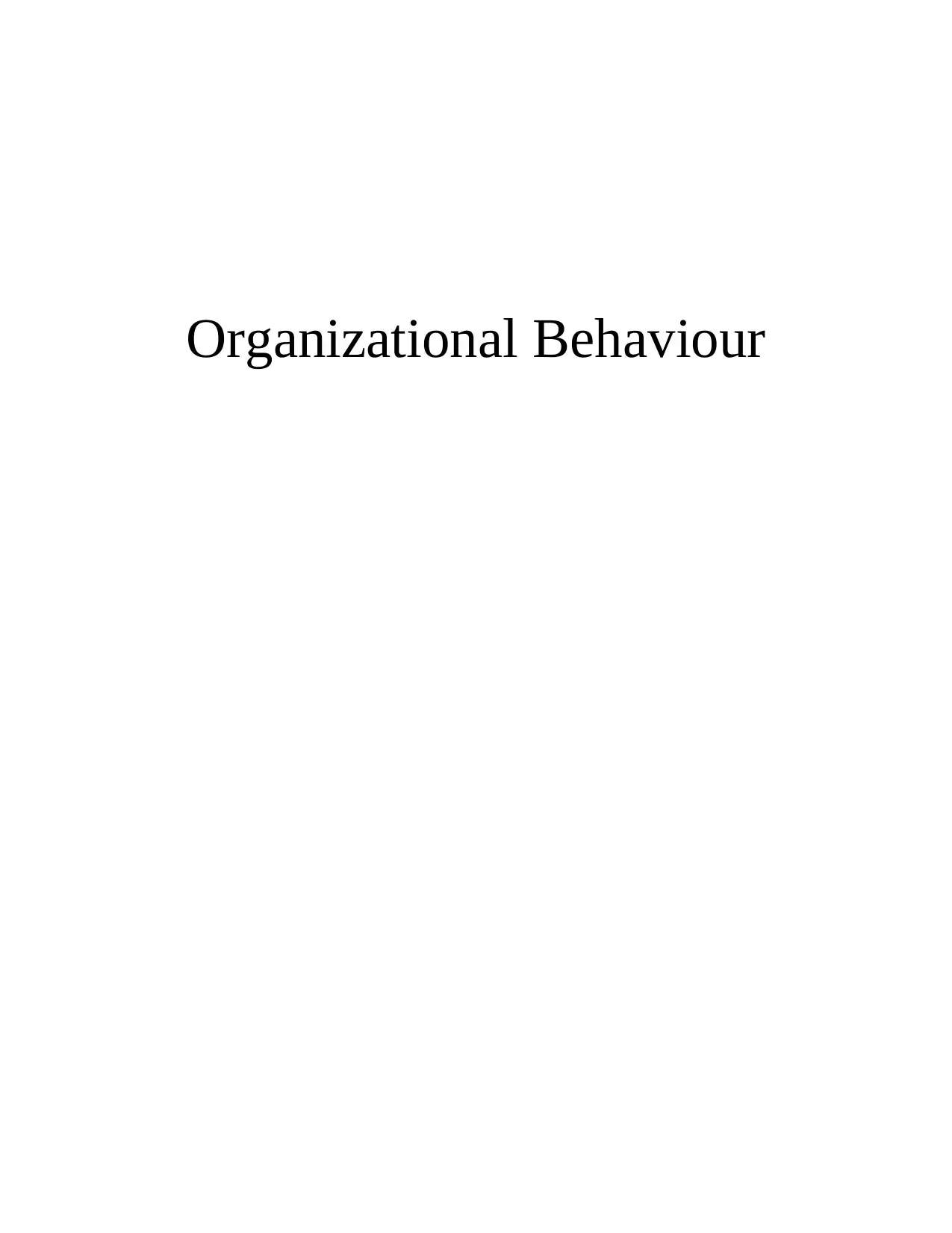
Organizational Behaviour
Paraphrase This Document
Need a fresh take? Get an instant paraphrase of this document with our AI Paraphraser
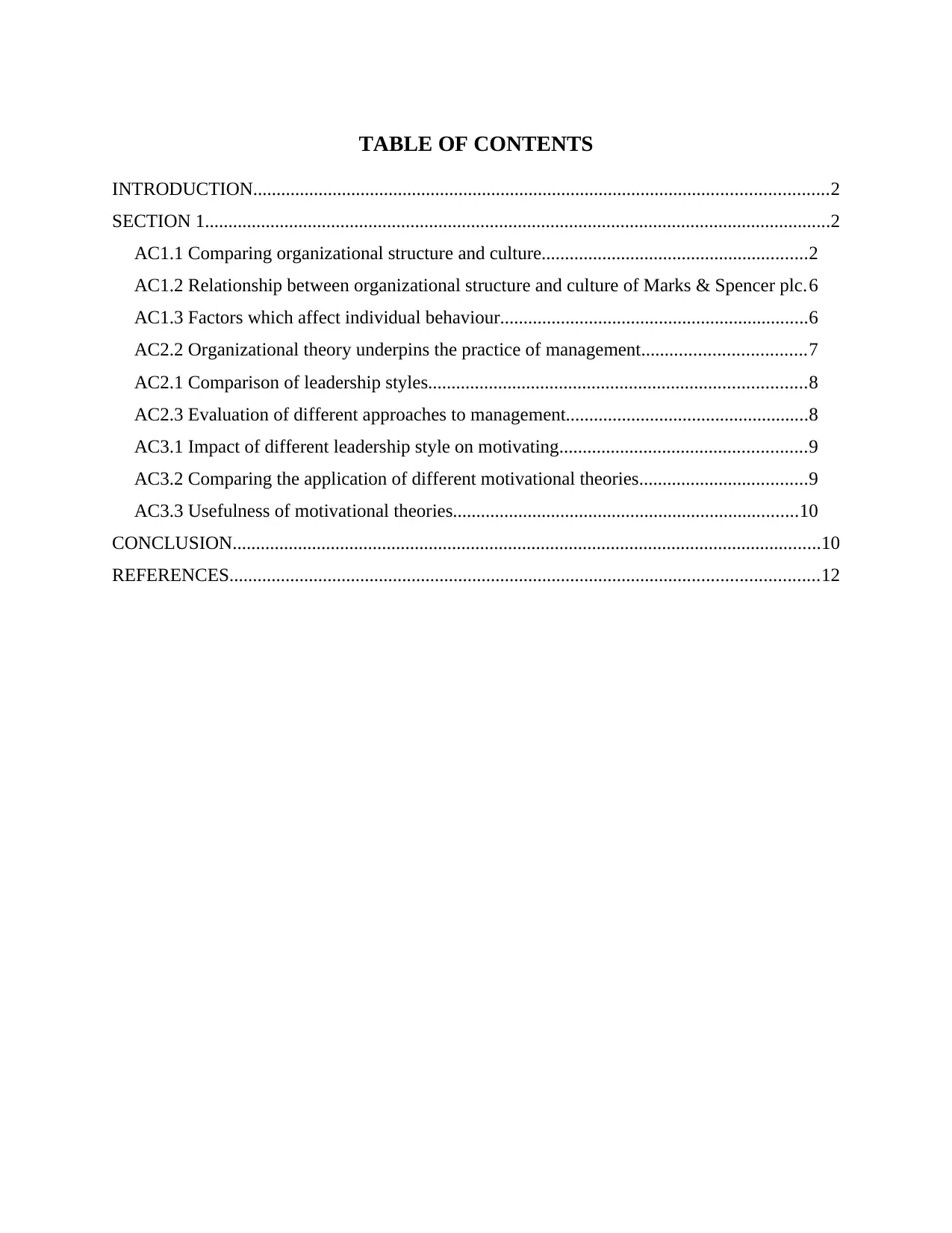
TABLE OF CONTENTS
INTRODUCTION...........................................................................................................................2
SECTION 1......................................................................................................................................2
AC1.1 Comparing organizational structure and culture.........................................................2
AC1.2 Relationship between organizational structure and culture of Marks & Spencer plc.6
AC1.3 Factors which affect individual behaviour..................................................................6
AC2.2 Organizational theory underpins the practice of management...................................7
AC2.1 Comparison of leadership styles.................................................................................8
AC2.3 Evaluation of different approaches to management....................................................8
AC3.1 Impact of different leadership style on motivating.....................................................9
AC3.2 Comparing the application of different motivational theories....................................9
AC3.3 Usefulness of motivational theories..........................................................................10
CONCLUSION..............................................................................................................................10
REFERENCES..............................................................................................................................12
INTRODUCTION...........................................................................................................................2
SECTION 1......................................................................................................................................2
AC1.1 Comparing organizational structure and culture.........................................................2
AC1.2 Relationship between organizational structure and culture of Marks & Spencer plc.6
AC1.3 Factors which affect individual behaviour..................................................................6
AC2.2 Organizational theory underpins the practice of management...................................7
AC2.1 Comparison of leadership styles.................................................................................8
AC2.3 Evaluation of different approaches to management....................................................8
AC3.1 Impact of different leadership style on motivating.....................................................9
AC3.2 Comparing the application of different motivational theories....................................9
AC3.3 Usefulness of motivational theories..........................................................................10
CONCLUSION..............................................................................................................................10
REFERENCES..............................................................................................................................12
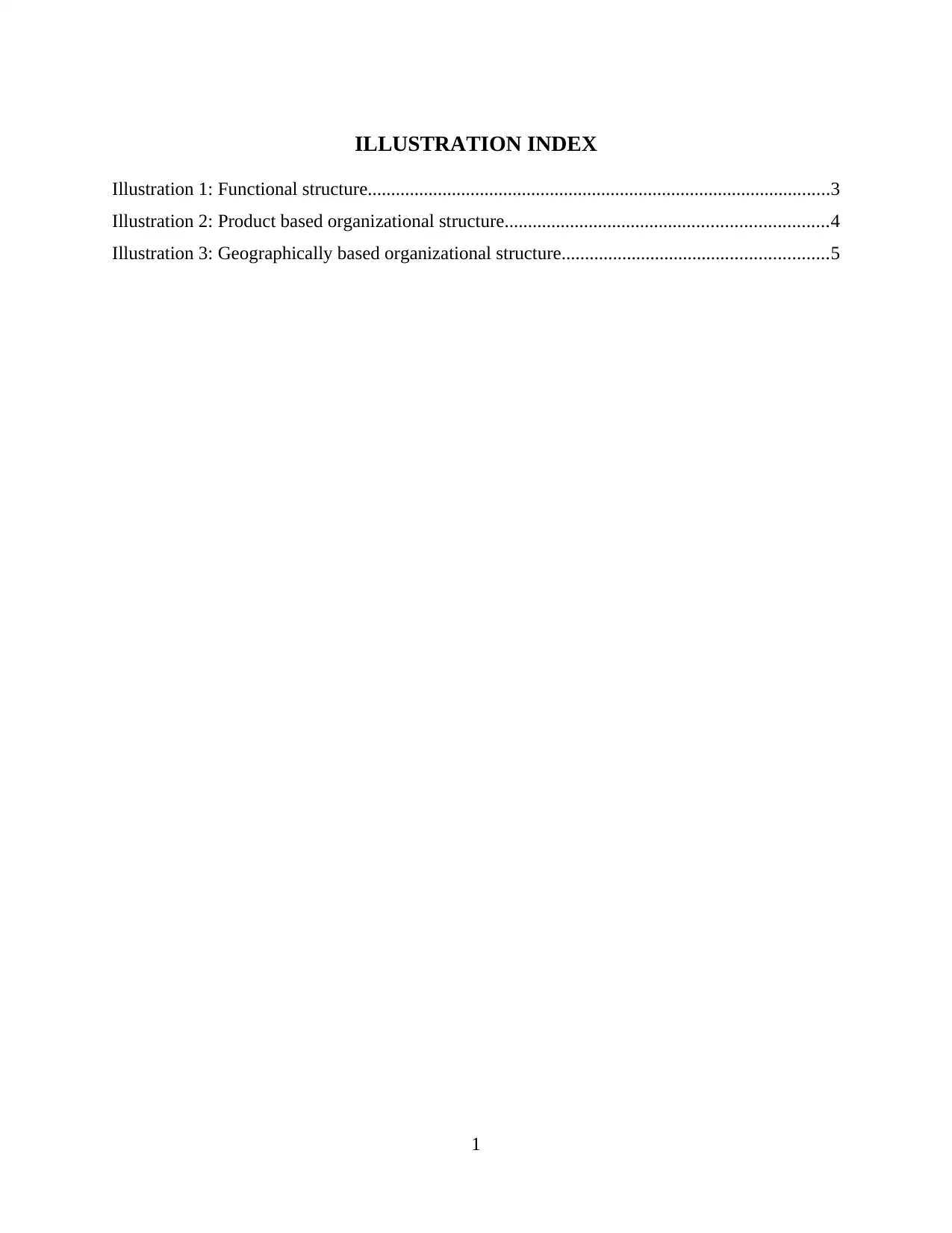
ILLUSTRATION INDEX
Illustration 1: Functional structure...................................................................................................3
Illustration 2: Product based organizational structure.....................................................................4
Illustration 3: Geographically based organizational structure.........................................................5
1
Illustration 1: Functional structure...................................................................................................3
Illustration 2: Product based organizational structure.....................................................................4
Illustration 3: Geographically based organizational structure.........................................................5
1
⊘ This is a preview!⊘
Do you want full access?
Subscribe today to unlock all pages.

Trusted by 1+ million students worldwide
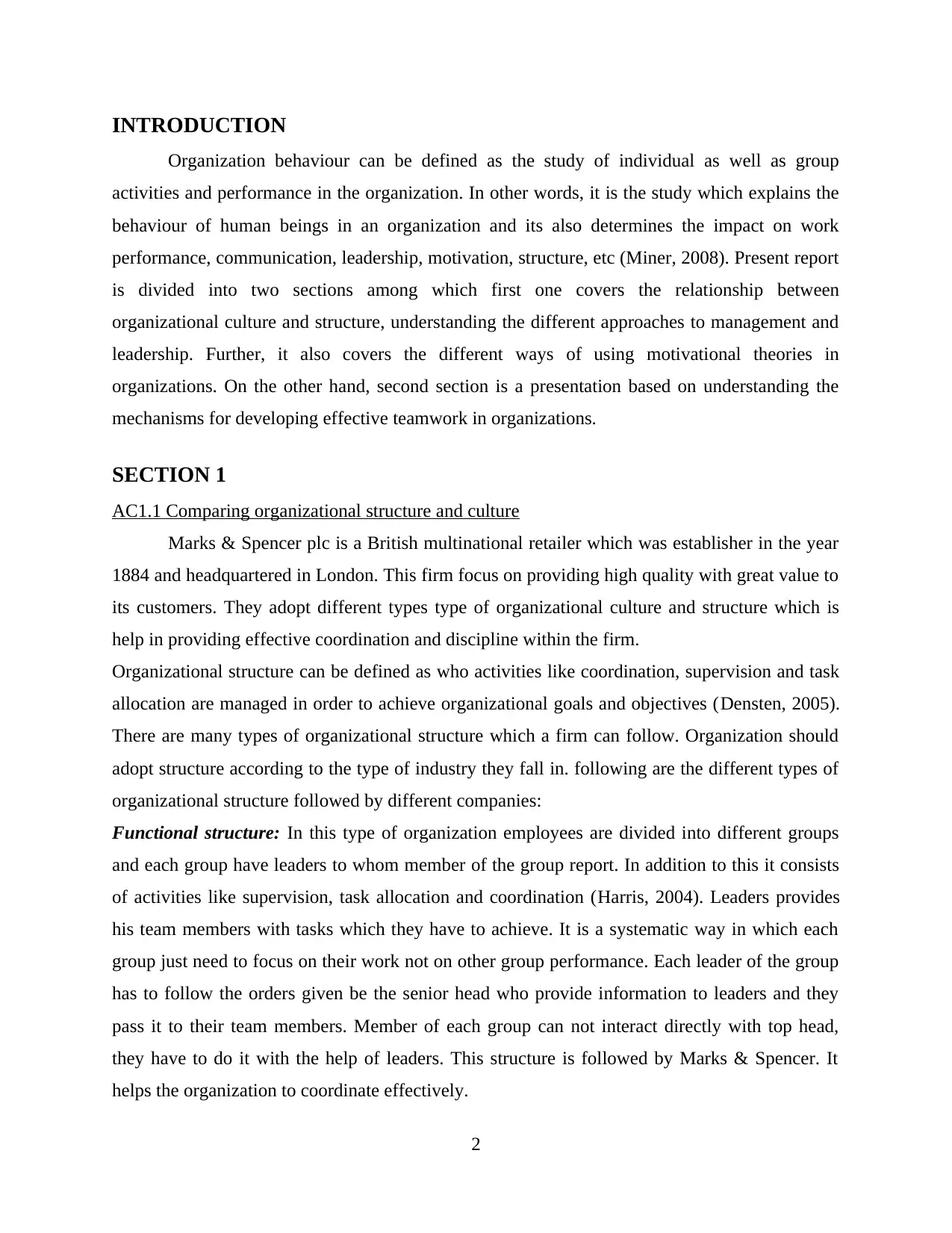
INTRODUCTION
Organization behaviour can be defined as the study of individual as well as group
activities and performance in the organization. In other words, it is the study which explains the
behaviour of human beings in an organization and its also determines the impact on work
performance, communication, leadership, motivation, structure, etc (Miner, 2008). Present report
is divided into two sections among which first one covers the relationship between
organizational culture and structure, understanding the different approaches to management and
leadership. Further, it also covers the different ways of using motivational theories in
organizations. On the other hand, second section is a presentation based on understanding the
mechanisms for developing effective teamwork in organizations.
SECTION 1
AC1.1 Comparing organizational structure and culture
Marks & Spencer plc is a British multinational retailer which was establisher in the year
1884 and headquartered in London. This firm focus on providing high quality with great value to
its customers. They adopt different types type of organizational culture and structure which is
help in providing effective coordination and discipline within the firm.
Organizational structure can be defined as who activities like coordination, supervision and task
allocation are managed in order to achieve organizational goals and objectives (Densten, 2005).
There are many types of organizational structure which a firm can follow. Organization should
adopt structure according to the type of industry they fall in. following are the different types of
organizational structure followed by different companies:
Functional structure: In this type of organization employees are divided into different groups
and each group have leaders to whom member of the group report. In addition to this it consists
of activities like supervision, task allocation and coordination (Harris, 2004). Leaders provides
his team members with tasks which they have to achieve. It is a systematic way in which each
group just need to focus on their work not on other group performance. Each leader of the group
has to follow the orders given be the senior head who provide information to leaders and they
pass it to their team members. Member of each group can not interact directly with top head,
they have to do it with the help of leaders. This structure is followed by Marks & Spencer. It
helps the organization to coordinate effectively.
2
Organization behaviour can be defined as the study of individual as well as group
activities and performance in the organization. In other words, it is the study which explains the
behaviour of human beings in an organization and its also determines the impact on work
performance, communication, leadership, motivation, structure, etc (Miner, 2008). Present report
is divided into two sections among which first one covers the relationship between
organizational culture and structure, understanding the different approaches to management and
leadership. Further, it also covers the different ways of using motivational theories in
organizations. On the other hand, second section is a presentation based on understanding the
mechanisms for developing effective teamwork in organizations.
SECTION 1
AC1.1 Comparing organizational structure and culture
Marks & Spencer plc is a British multinational retailer which was establisher in the year
1884 and headquartered in London. This firm focus on providing high quality with great value to
its customers. They adopt different types type of organizational culture and structure which is
help in providing effective coordination and discipline within the firm.
Organizational structure can be defined as who activities like coordination, supervision and task
allocation are managed in order to achieve organizational goals and objectives (Densten, 2005).
There are many types of organizational structure which a firm can follow. Organization should
adopt structure according to the type of industry they fall in. following are the different types of
organizational structure followed by different companies:
Functional structure: In this type of organization employees are divided into different groups
and each group have leaders to whom member of the group report. In addition to this it consists
of activities like supervision, task allocation and coordination (Harris, 2004). Leaders provides
his team members with tasks which they have to achieve. It is a systematic way in which each
group just need to focus on their work not on other group performance. Each leader of the group
has to follow the orders given be the senior head who provide information to leaders and they
pass it to their team members. Member of each group can not interact directly with top head,
they have to do it with the help of leaders. This structure is followed by Marks & Spencer. It
helps the organization to coordinate effectively.
2
Paraphrase This Document
Need a fresh take? Get an instant paraphrase of this document with our AI Paraphraser
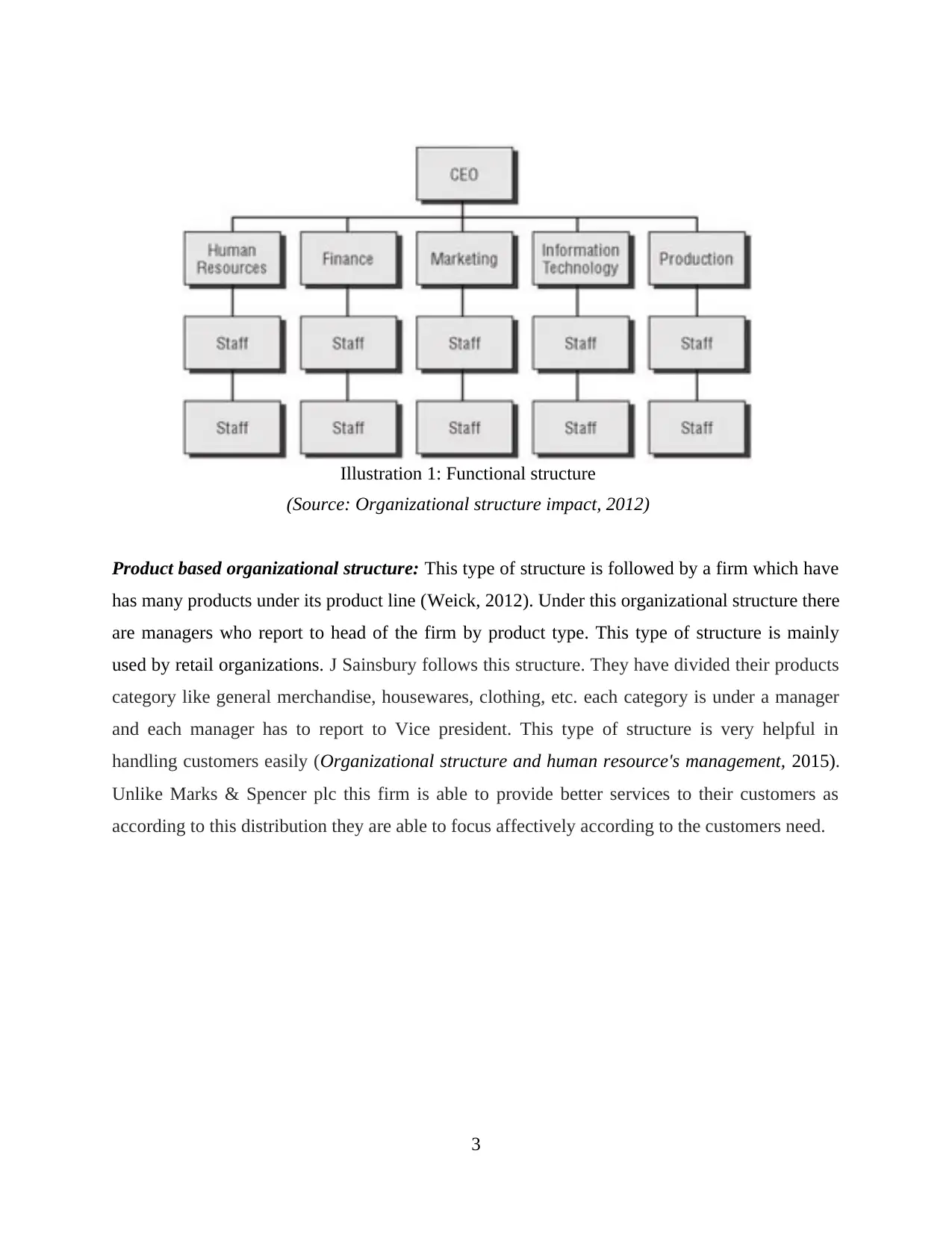
Product based organizational structure: This type of structure is followed by a firm which have
has many products under its product line (Weick, 2012). Under this organizational structure there
are managers who report to head of the firm by product type. This type of structure is mainly
used by retail organizations. J Sainsbury follows this structure. They have divided their products
category like general merchandise, housewares, clothing, etc. each category is under a manager
and each manager has to report to Vice president. This type of structure is very helpful in
handling customers easily (Organizational structure and human resource's management, 2015).
Unlike Marks & Spencer plc this firm is able to provide better services to their customers as
according to this distribution they are able to focus affectively according to the customers need.
3
Illustration 1: Functional structure
(Source: Organizational structure impact, 2012)
has many products under its product line (Weick, 2012). Under this organizational structure there
are managers who report to head of the firm by product type. This type of structure is mainly
used by retail organizations. J Sainsbury follows this structure. They have divided their products
category like general merchandise, housewares, clothing, etc. each category is under a manager
and each manager has to report to Vice president. This type of structure is very helpful in
handling customers easily (Organizational structure and human resource's management, 2015).
Unlike Marks & Spencer plc this firm is able to provide better services to their customers as
according to this distribution they are able to focus affectively according to the customers need.
3
Illustration 1: Functional structure
(Source: Organizational structure impact, 2012)
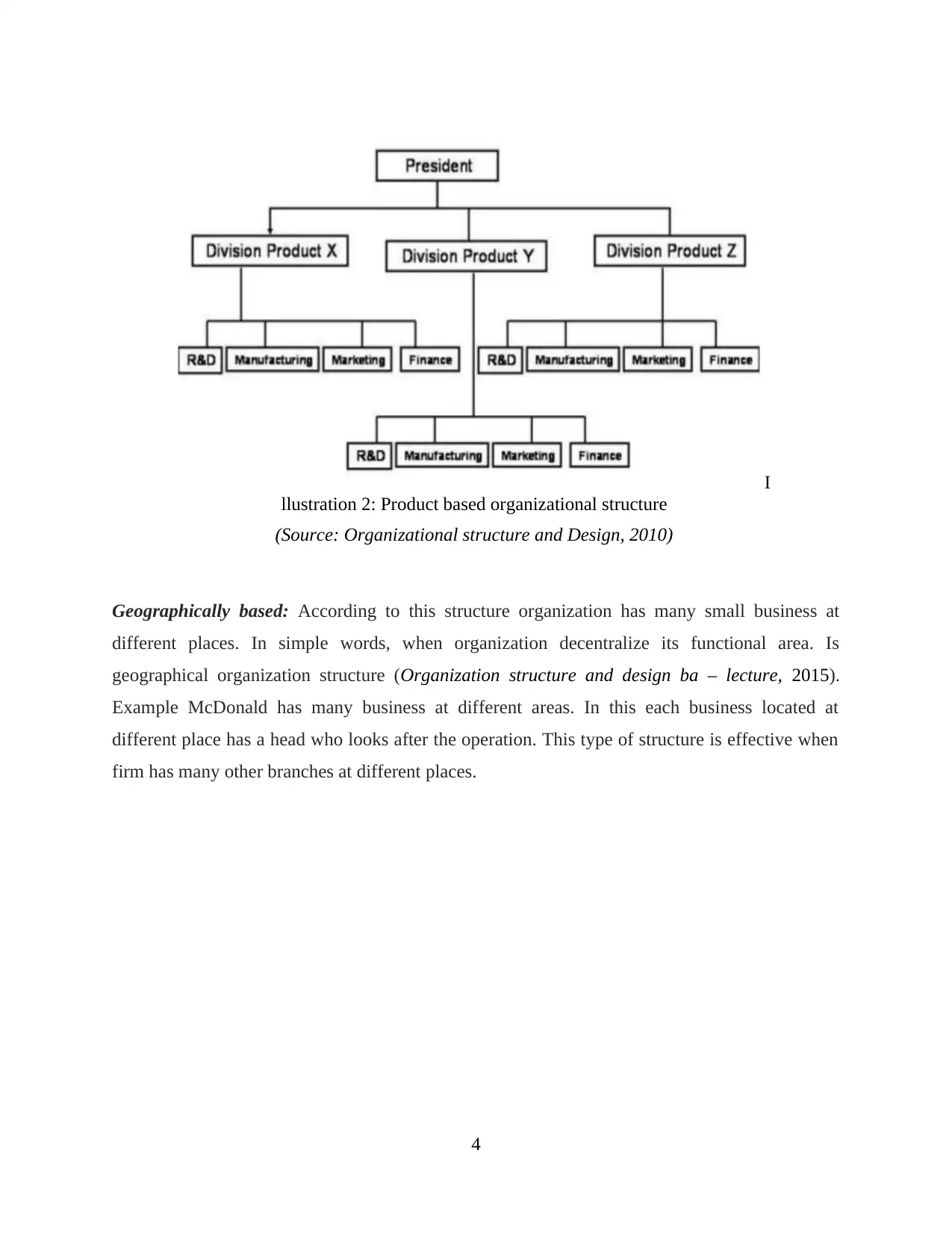
Geographically based: According to this structure organization has many small business at
different places. In simple words, when organization decentralize its functional area. Is
geographical organization structure (Organization structure and design ba – lecture, 2015).
Example McDonald has many business at different areas. In this each business located at
different place has a head who looks after the operation. This type of structure is effective when
firm has many other branches at different places.
4
I
llustration 2: Product based organizational structure
(Source: Organizational structure and Design, 2010)
different places. In simple words, when organization decentralize its functional area. Is
geographical organization structure (Organization structure and design ba – lecture, 2015).
Example McDonald has many business at different areas. In this each business located at
different place has a head who looks after the operation. This type of structure is effective when
firm has many other branches at different places.
4
I
llustration 2: Product based organizational structure
(Source: Organizational structure and Design, 2010)
⊘ This is a preview!⊘
Do you want full access?
Subscribe today to unlock all pages.

Trusted by 1+ million students worldwide
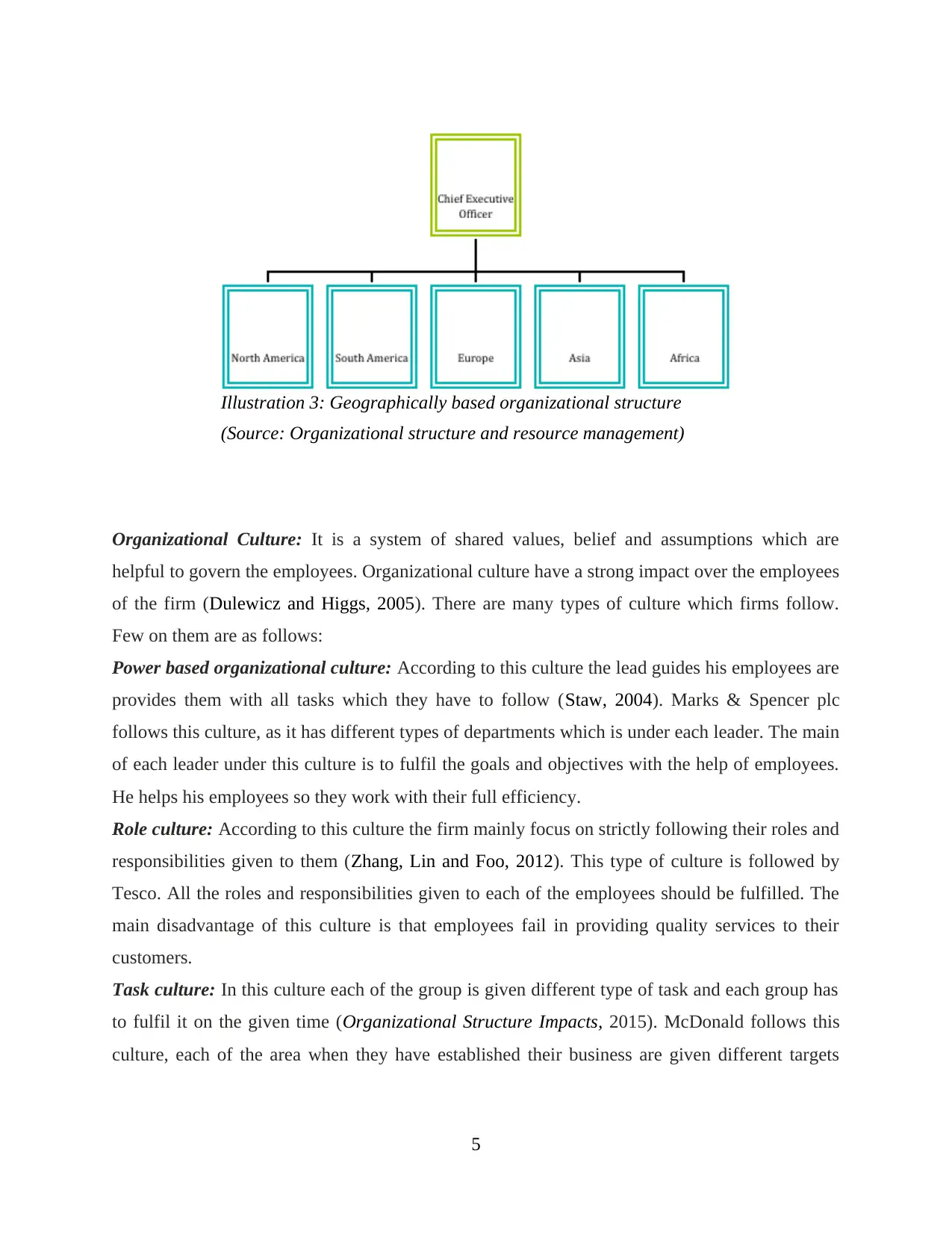
Organizational Culture: It is a system of shared values, belief and assumptions which are
helpful to govern the employees. Organizational culture have a strong impact over the employees
of the firm (Dulewicz and Higgs, 2005). There are many types of culture which firms follow.
Few on them are as follows:
Power based organizational culture: According to this culture the lead guides his employees are
provides them with all tasks which they have to follow (Staw, 2004). Marks & Spencer plc
follows this culture, as it has different types of departments which is under each leader. The main
of each leader under this culture is to fulfil the goals and objectives with the help of employees.
He helps his employees so they work with their full efficiency.
Role culture: According to this culture the firm mainly focus on strictly following their roles and
responsibilities given to them (Zhang, Lin and Foo, 2012). This type of culture is followed by
Tesco. All the roles and responsibilities given to each of the employees should be fulfilled. The
main disadvantage of this culture is that employees fail in providing quality services to their
customers.
Task culture: In this culture each of the group is given different type of task and each group has
to fulfil it on the given time (Organizational Structure Impacts, 2015). McDonald follows this
culture, each of the area when they have established their business are given different targets
5
Illustration 3: Geographically based organizational structure
(Source: Organizational structure and resource management)
helpful to govern the employees. Organizational culture have a strong impact over the employees
of the firm (Dulewicz and Higgs, 2005). There are many types of culture which firms follow.
Few on them are as follows:
Power based organizational culture: According to this culture the lead guides his employees are
provides them with all tasks which they have to follow (Staw, 2004). Marks & Spencer plc
follows this culture, as it has different types of departments which is under each leader. The main
of each leader under this culture is to fulfil the goals and objectives with the help of employees.
He helps his employees so they work with their full efficiency.
Role culture: According to this culture the firm mainly focus on strictly following their roles and
responsibilities given to them (Zhang, Lin and Foo, 2012). This type of culture is followed by
Tesco. All the roles and responsibilities given to each of the employees should be fulfilled. The
main disadvantage of this culture is that employees fail in providing quality services to their
customers.
Task culture: In this culture each of the group is given different type of task and each group has
to fulfil it on the given time (Organizational Structure Impacts, 2015). McDonald follows this
culture, each of the area when they have established their business are given different targets
5
Illustration 3: Geographically based organizational structure
(Source: Organizational structure and resource management)
Paraphrase This Document
Need a fresh take? Get an instant paraphrase of this document with our AI Paraphraser
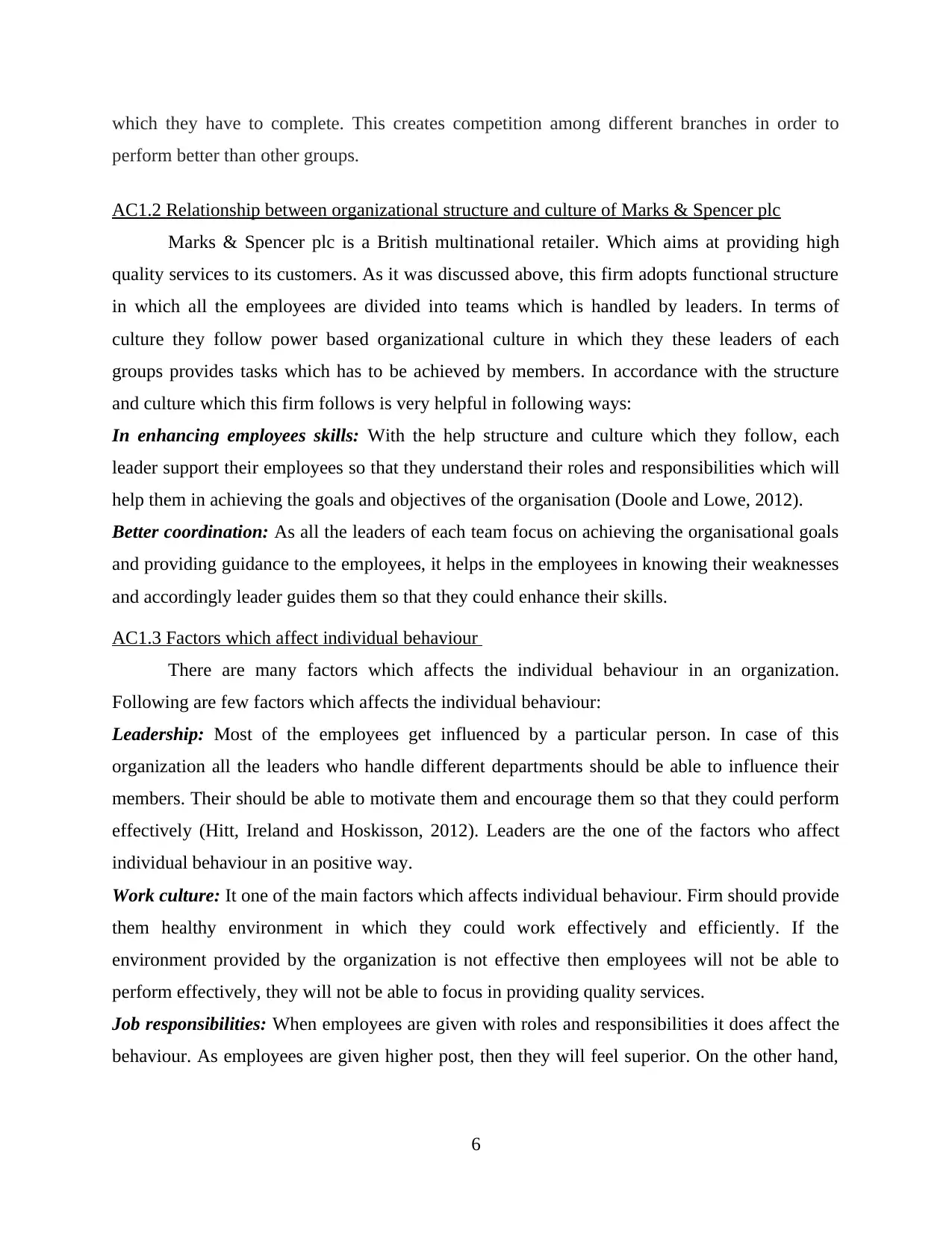
which they have to complete. This creates competition among different branches in order to
perform better than other groups.
AC1.2 Relationship between organizational structure and culture of Marks & Spencer plc
Marks & Spencer plc is a British multinational retailer. Which aims at providing high
quality services to its customers. As it was discussed above, this firm adopts functional structure
in which all the employees are divided into teams which is handled by leaders. In terms of
culture they follow power based organizational culture in which they these leaders of each
groups provides tasks which has to be achieved by members. In accordance with the structure
and culture which this firm follows is very helpful in following ways:
In enhancing employees skills: With the help structure and culture which they follow, each
leader support their employees so that they understand their roles and responsibilities which will
help them in achieving the goals and objectives of the organisation (Doole and Lowe, 2012).
Better coordination: As all the leaders of each team focus on achieving the organisational goals
and providing guidance to the employees, it helps in the employees in knowing their weaknesses
and accordingly leader guides them so that they could enhance their skills.
AC1.3 Factors which affect individual behaviour
There are many factors which affects the individual behaviour in an organization.
Following are few factors which affects the individual behaviour:
Leadership: Most of the employees get influenced by a particular person. In case of this
organization all the leaders who handle different departments should be able to influence their
members. Their should be able to motivate them and encourage them so that they could perform
effectively (Hitt, Ireland and Hoskisson, 2012). Leaders are the one of the factors who affect
individual behaviour in an positive way.
Work culture: It one of the main factors which affects individual behaviour. Firm should provide
them healthy environment in which they could work effectively and efficiently. If the
environment provided by the organization is not effective then employees will not be able to
perform effectively, they will not be able to focus in providing quality services.
Job responsibilities: When employees are given with roles and responsibilities it does affect the
behaviour. As employees are given higher post, then they will feel superior. On the other hand,
6
perform better than other groups.
AC1.2 Relationship between organizational structure and culture of Marks & Spencer plc
Marks & Spencer plc is a British multinational retailer. Which aims at providing high
quality services to its customers. As it was discussed above, this firm adopts functional structure
in which all the employees are divided into teams which is handled by leaders. In terms of
culture they follow power based organizational culture in which they these leaders of each
groups provides tasks which has to be achieved by members. In accordance with the structure
and culture which this firm follows is very helpful in following ways:
In enhancing employees skills: With the help structure and culture which they follow, each
leader support their employees so that they understand their roles and responsibilities which will
help them in achieving the goals and objectives of the organisation (Doole and Lowe, 2012).
Better coordination: As all the leaders of each team focus on achieving the organisational goals
and providing guidance to the employees, it helps in the employees in knowing their weaknesses
and accordingly leader guides them so that they could enhance their skills.
AC1.3 Factors which affect individual behaviour
There are many factors which affects the individual behaviour in an organization.
Following are few factors which affects the individual behaviour:
Leadership: Most of the employees get influenced by a particular person. In case of this
organization all the leaders who handle different departments should be able to influence their
members. Their should be able to motivate them and encourage them so that they could perform
effectively (Hitt, Ireland and Hoskisson, 2012). Leaders are the one of the factors who affect
individual behaviour in an positive way.
Work culture: It one of the main factors which affects individual behaviour. Firm should provide
them healthy environment in which they could work effectively and efficiently. If the
environment provided by the organization is not effective then employees will not be able to
perform effectively, they will not be able to focus in providing quality services.
Job responsibilities: When employees are given with roles and responsibilities it does affect the
behaviour. As employees are given higher post, then they will feel superior. On the other hand,
6
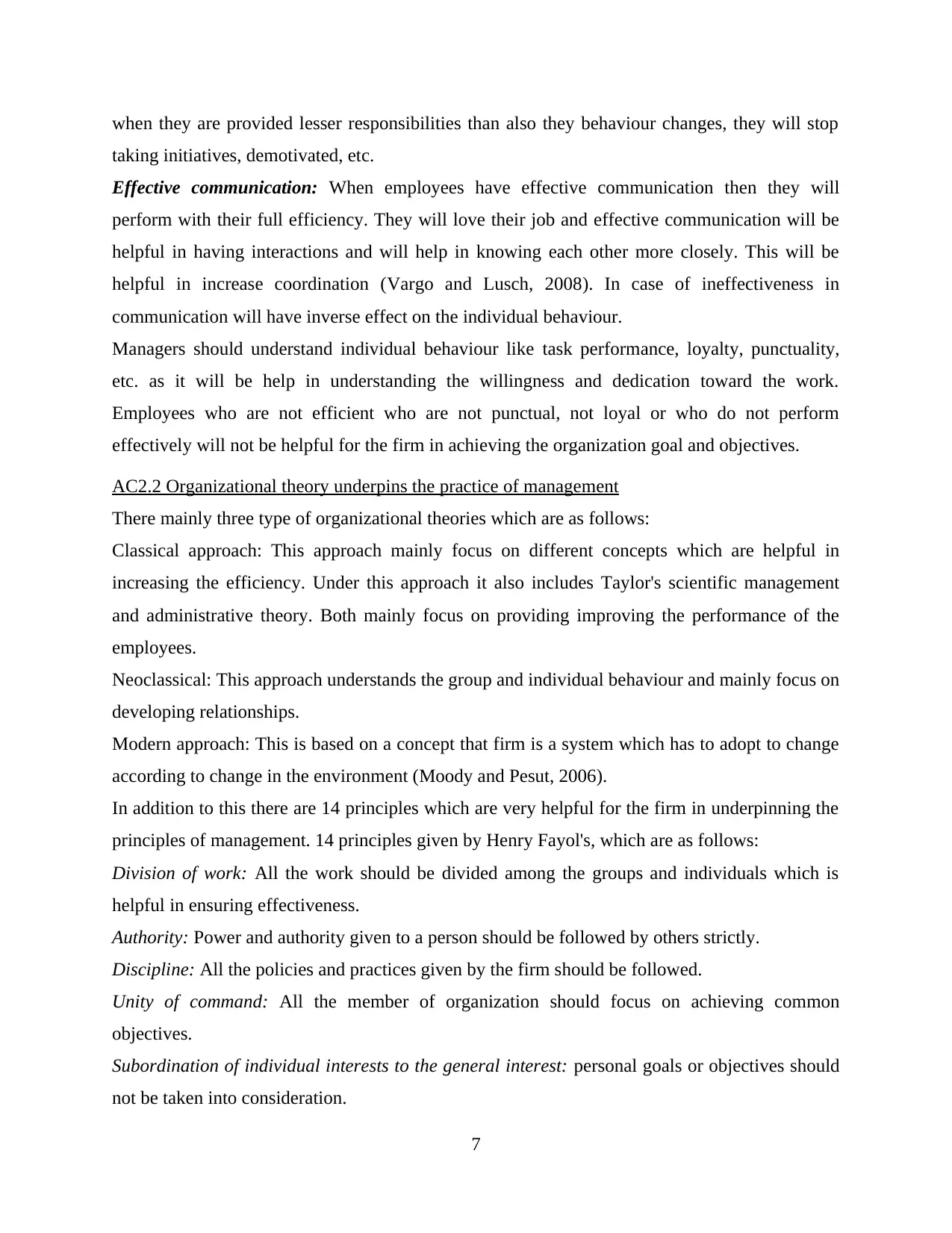
when they are provided lesser responsibilities than also they behaviour changes, they will stop
taking initiatives, demotivated, etc.
Effective communication: When employees have effective communication then they will
perform with their full efficiency. They will love their job and effective communication will be
helpful in having interactions and will help in knowing each other more closely. This will be
helpful in increase coordination (Vargo and Lusch, 2008). In case of ineffectiveness in
communication will have inverse effect on the individual behaviour.
Managers should understand individual behaviour like task performance, loyalty, punctuality,
etc. as it will be help in understanding the willingness and dedication toward the work.
Employees who are not efficient who are not punctual, not loyal or who do not perform
effectively will not be helpful for the firm in achieving the organization goal and objectives.
AC2.2 Organizational theory underpins the practice of management
There mainly three type of organizational theories which are as follows:
Classical approach: This approach mainly focus on different concepts which are helpful in
increasing the efficiency. Under this approach it also includes Taylor's scientific management
and administrative theory. Both mainly focus on providing improving the performance of the
employees.
Neoclassical: This approach understands the group and individual behaviour and mainly focus on
developing relationships.
Modern approach: This is based on a concept that firm is a system which has to adopt to change
according to change in the environment (Moody and Pesut, 2006).
In addition to this there are 14 principles which are very helpful for the firm in underpinning the
principles of management. 14 principles given by Henry Fayol's, which are as follows:
Division of work: All the work should be divided among the groups and individuals which is
helpful in ensuring effectiveness.
Authority: Power and authority given to a person should be followed by others strictly.
Discipline: All the policies and practices given by the firm should be followed.
Unity of command: All the member of organization should focus on achieving common
objectives.
Subordination of individual interests to the general interest: personal goals or objectives should
not be taken into consideration.
7
taking initiatives, demotivated, etc.
Effective communication: When employees have effective communication then they will
perform with their full efficiency. They will love their job and effective communication will be
helpful in having interactions and will help in knowing each other more closely. This will be
helpful in increase coordination (Vargo and Lusch, 2008). In case of ineffectiveness in
communication will have inverse effect on the individual behaviour.
Managers should understand individual behaviour like task performance, loyalty, punctuality,
etc. as it will be help in understanding the willingness and dedication toward the work.
Employees who are not efficient who are not punctual, not loyal or who do not perform
effectively will not be helpful for the firm in achieving the organization goal and objectives.
AC2.2 Organizational theory underpins the practice of management
There mainly three type of organizational theories which are as follows:
Classical approach: This approach mainly focus on different concepts which are helpful in
increasing the efficiency. Under this approach it also includes Taylor's scientific management
and administrative theory. Both mainly focus on providing improving the performance of the
employees.
Neoclassical: This approach understands the group and individual behaviour and mainly focus on
developing relationships.
Modern approach: This is based on a concept that firm is a system which has to adopt to change
according to change in the environment (Moody and Pesut, 2006).
In addition to this there are 14 principles which are very helpful for the firm in underpinning the
principles of management. 14 principles given by Henry Fayol's, which are as follows:
Division of work: All the work should be divided among the groups and individuals which is
helpful in ensuring effectiveness.
Authority: Power and authority given to a person should be followed by others strictly.
Discipline: All the policies and practices given by the firm should be followed.
Unity of command: All the member of organization should focus on achieving common
objectives.
Subordination of individual interests to the general interest: personal goals or objectives should
not be taken into consideration.
7
⊘ This is a preview!⊘
Do you want full access?
Subscribe today to unlock all pages.

Trusted by 1+ million students worldwide
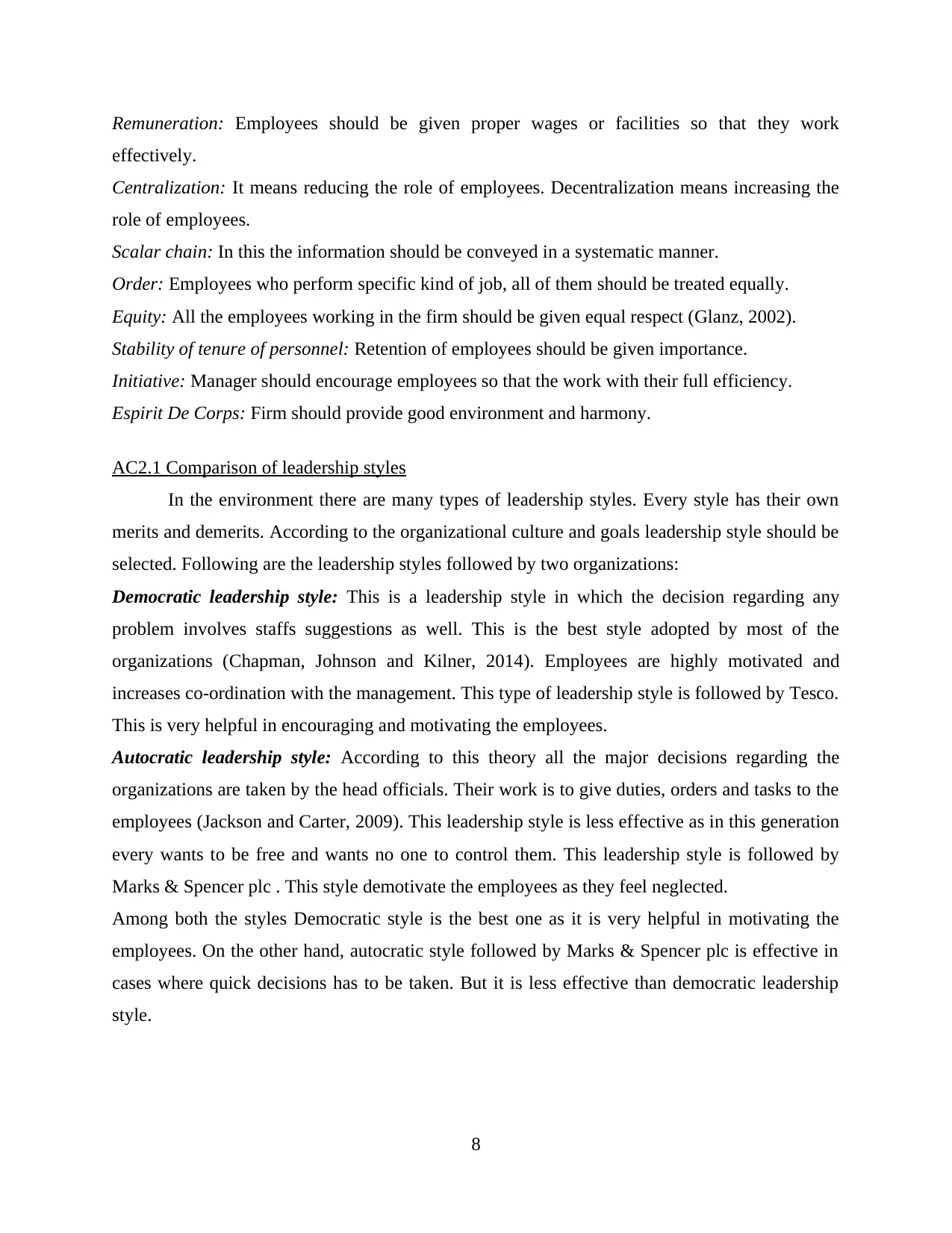
Remuneration: Employees should be given proper wages or facilities so that they work
effectively.
Centralization: It means reducing the role of employees. Decentralization means increasing the
role of employees.
Scalar chain: In this the information should be conveyed in a systematic manner.
Order: Employees who perform specific kind of job, all of them should be treated equally.
Equity: All the employees working in the firm should be given equal respect (Glanz, 2002).
Stability of tenure of personnel: Retention of employees should be given importance.
Initiative: Manager should encourage employees so that the work with their full efficiency.
Espirit De Corps: Firm should provide good environment and harmony.
AC2.1 Comparison of leadership styles
In the environment there are many types of leadership styles. Every style has their own
merits and demerits. According to the organizational culture and goals leadership style should be
selected. Following are the leadership styles followed by two organizations:
Democratic leadership style: This is a leadership style in which the decision regarding any
problem involves staffs suggestions as well. This is the best style adopted by most of the
organizations (Chapman, Johnson and Kilner, 2014). Employees are highly motivated and
increases co-ordination with the management. This type of leadership style is followed by Tesco.
This is very helpful in encouraging and motivating the employees.
Autocratic leadership style: According to this theory all the major decisions regarding the
organizations are taken by the head officials. Their work is to give duties, orders and tasks to the
employees (Jackson and Carter, 2009). This leadership style is less effective as in this generation
every wants to be free and wants no one to control them. This leadership style is followed by
Marks & Spencer plc . This style demotivate the employees as they feel neglected.
Among both the styles Democratic style is the best one as it is very helpful in motivating the
employees. On the other hand, autocratic style followed by Marks & Spencer plc is effective in
cases where quick decisions has to be taken. But it is less effective than democratic leadership
style.
8
effectively.
Centralization: It means reducing the role of employees. Decentralization means increasing the
role of employees.
Scalar chain: In this the information should be conveyed in a systematic manner.
Order: Employees who perform specific kind of job, all of them should be treated equally.
Equity: All the employees working in the firm should be given equal respect (Glanz, 2002).
Stability of tenure of personnel: Retention of employees should be given importance.
Initiative: Manager should encourage employees so that the work with their full efficiency.
Espirit De Corps: Firm should provide good environment and harmony.
AC2.1 Comparison of leadership styles
In the environment there are many types of leadership styles. Every style has their own
merits and demerits. According to the organizational culture and goals leadership style should be
selected. Following are the leadership styles followed by two organizations:
Democratic leadership style: This is a leadership style in which the decision regarding any
problem involves staffs suggestions as well. This is the best style adopted by most of the
organizations (Chapman, Johnson and Kilner, 2014). Employees are highly motivated and
increases co-ordination with the management. This type of leadership style is followed by Tesco.
This is very helpful in encouraging and motivating the employees.
Autocratic leadership style: According to this theory all the major decisions regarding the
organizations are taken by the head officials. Their work is to give duties, orders and tasks to the
employees (Jackson and Carter, 2009). This leadership style is less effective as in this generation
every wants to be free and wants no one to control them. This leadership style is followed by
Marks & Spencer plc . This style demotivate the employees as they feel neglected.
Among both the styles Democratic style is the best one as it is very helpful in motivating the
employees. On the other hand, autocratic style followed by Marks & Spencer plc is effective in
cases where quick decisions has to be taken. But it is less effective than democratic leadership
style.
8
Paraphrase This Document
Need a fresh take? Get an instant paraphrase of this document with our AI Paraphraser
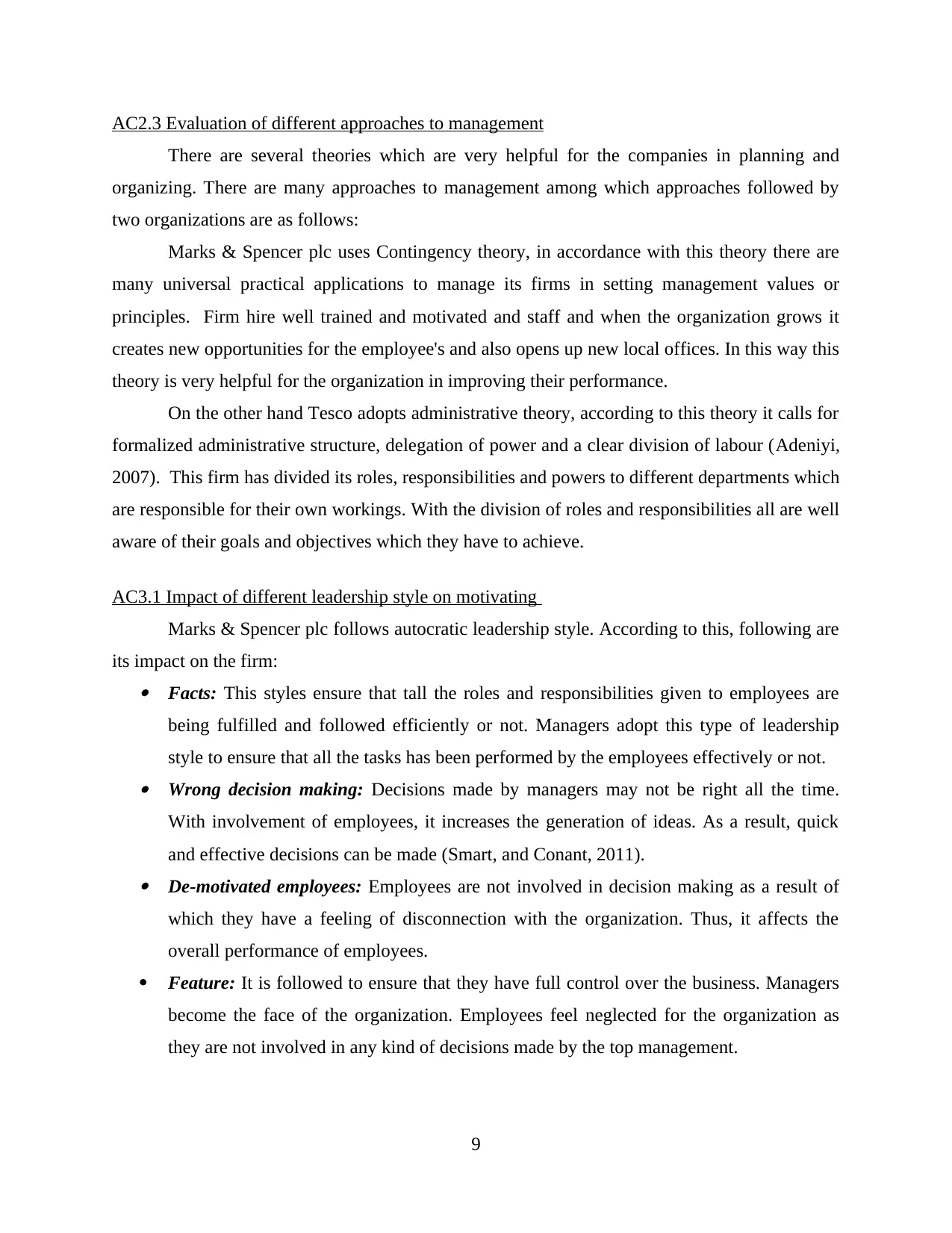
AC2.3 Evaluation of different approaches to management
There are several theories which are very helpful for the companies in planning and
organizing. There are many approaches to management among which approaches followed by
two organizations are as follows:
Marks & Spencer plc uses Contingency theory, in accordance with this theory there are
many universal practical applications to manage its firms in setting management values or
principles. Firm hire well trained and motivated and staff and when the organization grows it
creates new opportunities for the employee's and also opens up new local offices. In this way this
theory is very helpful for the organization in improving their performance.
On the other hand Tesco adopts administrative theory, according to this theory it calls for
formalized administrative structure, delegation of power and a clear division of labour (Adeniyi,
2007). This firm has divided its roles, responsibilities and powers to different departments which
are responsible for their own workings. With the division of roles and responsibilities all are well
aware of their goals and objectives which they have to achieve.
AC3.1 Impact of different leadership style on motivating
Marks & Spencer plc follows autocratic leadership style. According to this, following are
its impact on the firm: Facts: This styles ensure that tall the roles and responsibilities given to employees are
being fulfilled and followed efficiently or not. Managers adopt this type of leadership
style to ensure that all the tasks has been performed by the employees effectively or not. Wrong decision making: Decisions made by managers may not be right all the time.
With involvement of employees, it increases the generation of ideas. As a result, quick
and effective decisions can be made (Smart, and Conant, 2011). De-motivated employees: Employees are not involved in decision making as a result of
which they have a feeling of disconnection with the organization. Thus, it affects the
overall performance of employees.
Feature: It is followed to ensure that they have full control over the business. Managers
become the face of the organization. Employees feel neglected for the organization as
they are not involved in any kind of decisions made by the top management.
9
There are several theories which are very helpful for the companies in planning and
organizing. There are many approaches to management among which approaches followed by
two organizations are as follows:
Marks & Spencer plc uses Contingency theory, in accordance with this theory there are
many universal practical applications to manage its firms in setting management values or
principles. Firm hire well trained and motivated and staff and when the organization grows it
creates new opportunities for the employee's and also opens up new local offices. In this way this
theory is very helpful for the organization in improving their performance.
On the other hand Tesco adopts administrative theory, according to this theory it calls for
formalized administrative structure, delegation of power and a clear division of labour (Adeniyi,
2007). This firm has divided its roles, responsibilities and powers to different departments which
are responsible for their own workings. With the division of roles and responsibilities all are well
aware of their goals and objectives which they have to achieve.
AC3.1 Impact of different leadership style on motivating
Marks & Spencer plc follows autocratic leadership style. According to this, following are
its impact on the firm: Facts: This styles ensure that tall the roles and responsibilities given to employees are
being fulfilled and followed efficiently or not. Managers adopt this type of leadership
style to ensure that all the tasks has been performed by the employees effectively or not. Wrong decision making: Decisions made by managers may not be right all the time.
With involvement of employees, it increases the generation of ideas. As a result, quick
and effective decisions can be made (Smart, and Conant, 2011). De-motivated employees: Employees are not involved in decision making as a result of
which they have a feeling of disconnection with the organization. Thus, it affects the
overall performance of employees.
Feature: It is followed to ensure that they have full control over the business. Managers
become the face of the organization. Employees feel neglected for the organization as
they are not involved in any kind of decisions made by the top management.
9
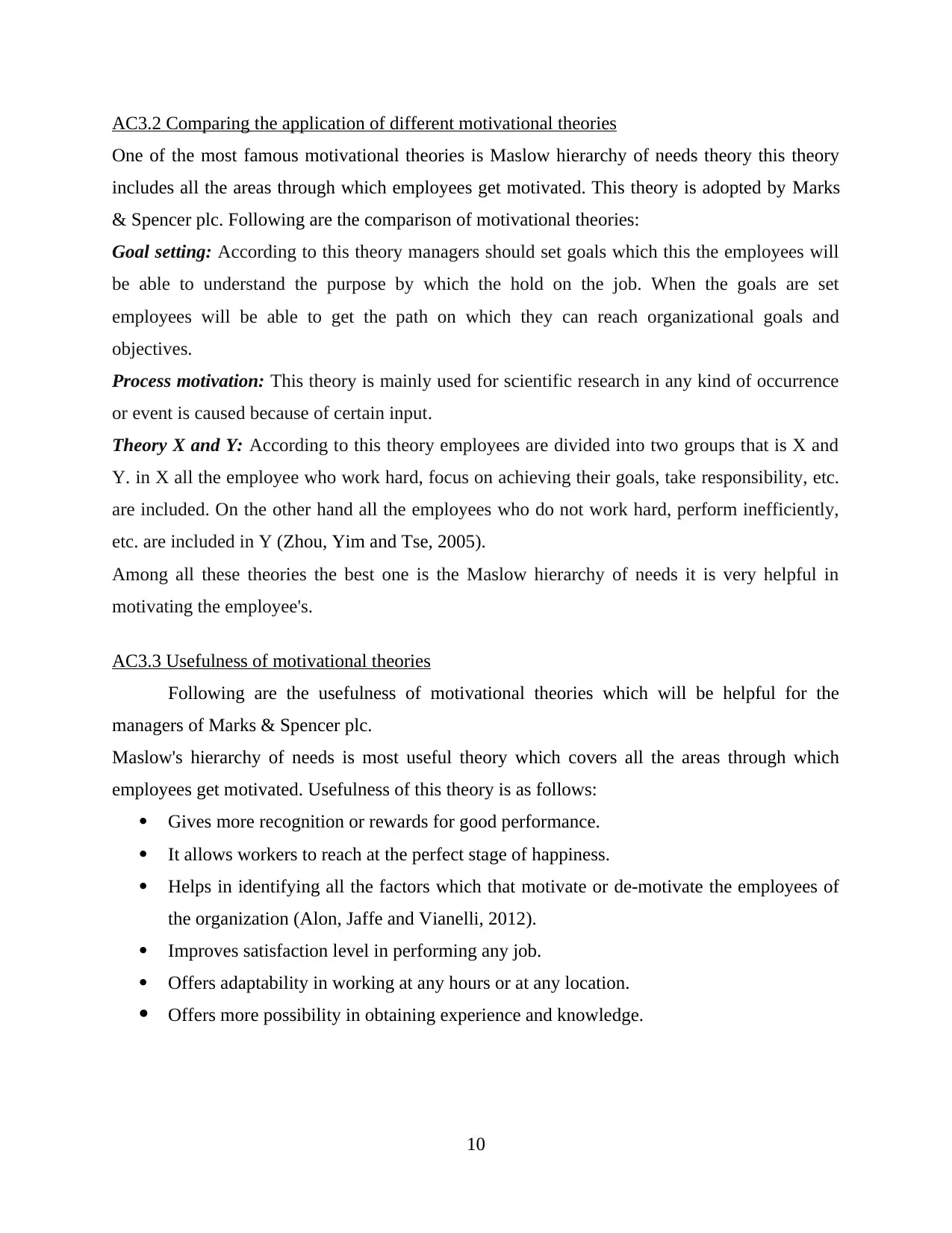
AC3.2 Comparing the application of different motivational theories
One of the most famous motivational theories is Maslow hierarchy of needs theory this theory
includes all the areas through which employees get motivated. This theory is adopted by Marks
& Spencer plc. Following are the comparison of motivational theories:
Goal setting: According to this theory managers should set goals which this the employees will
be able to understand the purpose by which the hold on the job. When the goals are set
employees will be able to get the path on which they can reach organizational goals and
objectives.
Process motivation: This theory is mainly used for scientific research in any kind of occurrence
or event is caused because of certain input.
Theory X and Y: According to this theory employees are divided into two groups that is X and
Y. in X all the employee who work hard, focus on achieving their goals, take responsibility, etc.
are included. On the other hand all the employees who do not work hard, perform inefficiently,
etc. are included in Y (Zhou, Yim and Tse, 2005).
Among all these theories the best one is the Maslow hierarchy of needs it is very helpful in
motivating the employee's.
AC3.3 Usefulness of motivational theories
Following are the usefulness of motivational theories which will be helpful for the
managers of Marks & Spencer plc.
Maslow's hierarchy of needs is most useful theory which covers all the areas through which
employees get motivated. Usefulness of this theory is as follows:
Gives more recognition or rewards for good performance.
It allows workers to reach at the perfect stage of happiness.
Helps in identifying all the factors which that motivate or de-motivate the employees of
the organization (Alon, Jaffe and Vianelli, 2012).
Improves satisfaction level in performing any job.
Offers adaptability in working at any hours or at any location.
Offers more possibility in obtaining experience and knowledge.
10
One of the most famous motivational theories is Maslow hierarchy of needs theory this theory
includes all the areas through which employees get motivated. This theory is adopted by Marks
& Spencer plc. Following are the comparison of motivational theories:
Goal setting: According to this theory managers should set goals which this the employees will
be able to understand the purpose by which the hold on the job. When the goals are set
employees will be able to get the path on which they can reach organizational goals and
objectives.
Process motivation: This theory is mainly used for scientific research in any kind of occurrence
or event is caused because of certain input.
Theory X and Y: According to this theory employees are divided into two groups that is X and
Y. in X all the employee who work hard, focus on achieving their goals, take responsibility, etc.
are included. On the other hand all the employees who do not work hard, perform inefficiently,
etc. are included in Y (Zhou, Yim and Tse, 2005).
Among all these theories the best one is the Maslow hierarchy of needs it is very helpful in
motivating the employee's.
AC3.3 Usefulness of motivational theories
Following are the usefulness of motivational theories which will be helpful for the
managers of Marks & Spencer plc.
Maslow's hierarchy of needs is most useful theory which covers all the areas through which
employees get motivated. Usefulness of this theory is as follows:
Gives more recognition or rewards for good performance.
It allows workers to reach at the perfect stage of happiness.
Helps in identifying all the factors which that motivate or de-motivate the employees of
the organization (Alon, Jaffe and Vianelli, 2012).
Improves satisfaction level in performing any job.
Offers adaptability in working at any hours or at any location.
Offers more possibility in obtaining experience and knowledge.
10
⊘ This is a preview!⊘
Do you want full access?
Subscribe today to unlock all pages.

Trusted by 1+ million students worldwide
1 out of 15
Related Documents
Your All-in-One AI-Powered Toolkit for Academic Success.
+13062052269
info@desklib.com
Available 24*7 on WhatsApp / Email
![[object Object]](/_next/static/media/star-bottom.7253800d.svg)
Unlock your academic potential
Copyright © 2020–2025 A2Z Services. All Rights Reserved. Developed and managed by ZUCOL.





